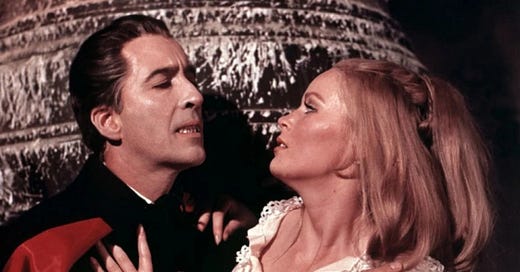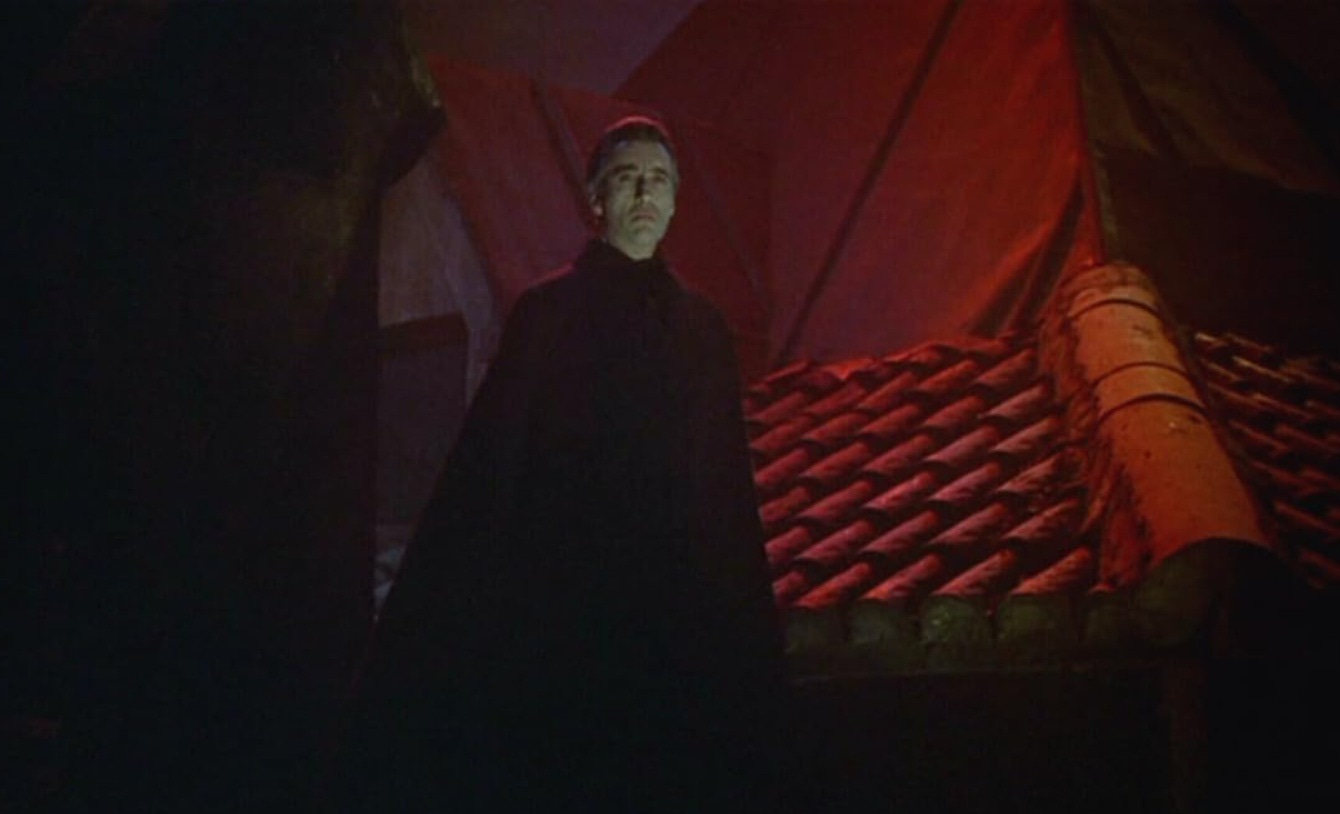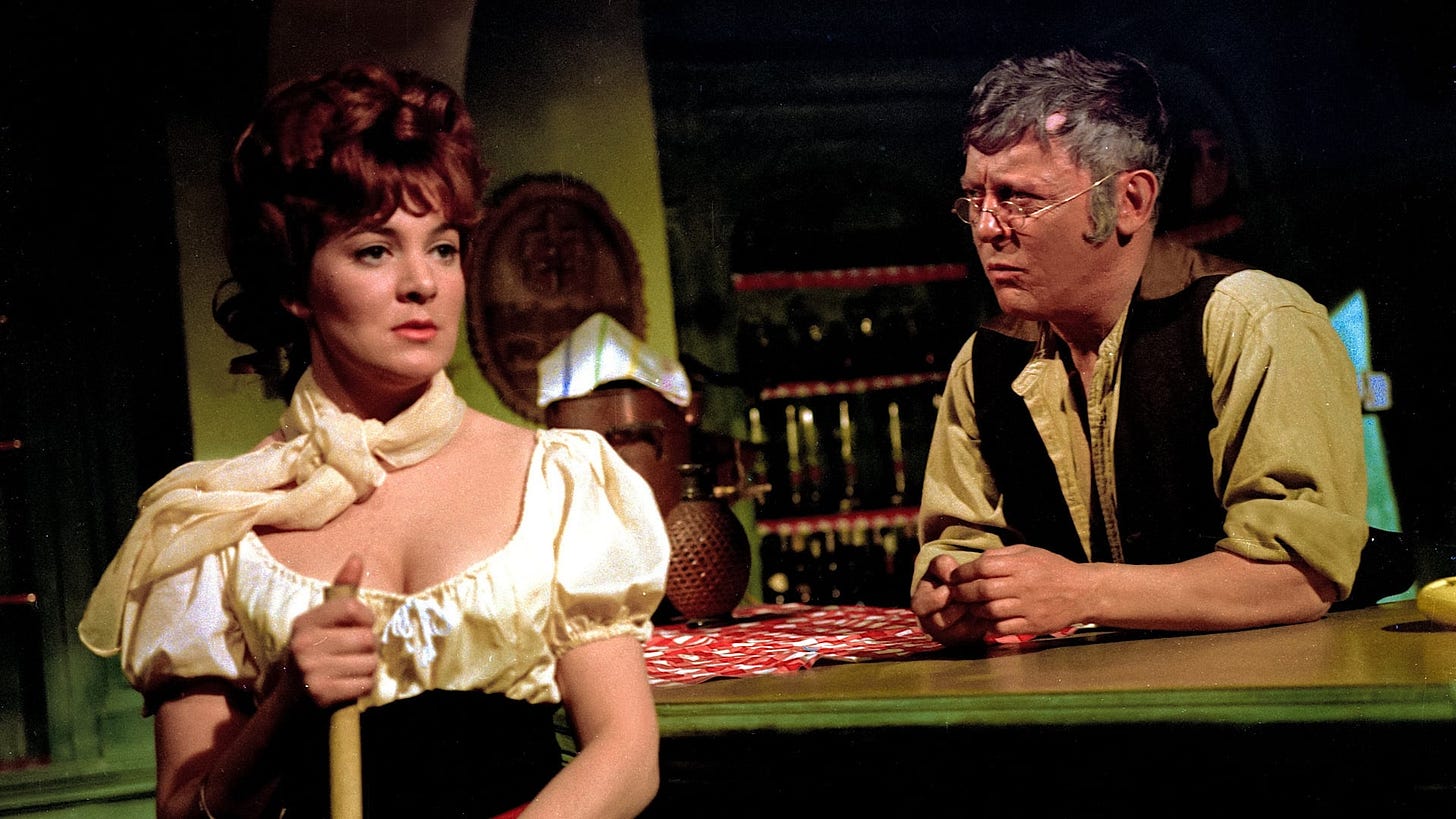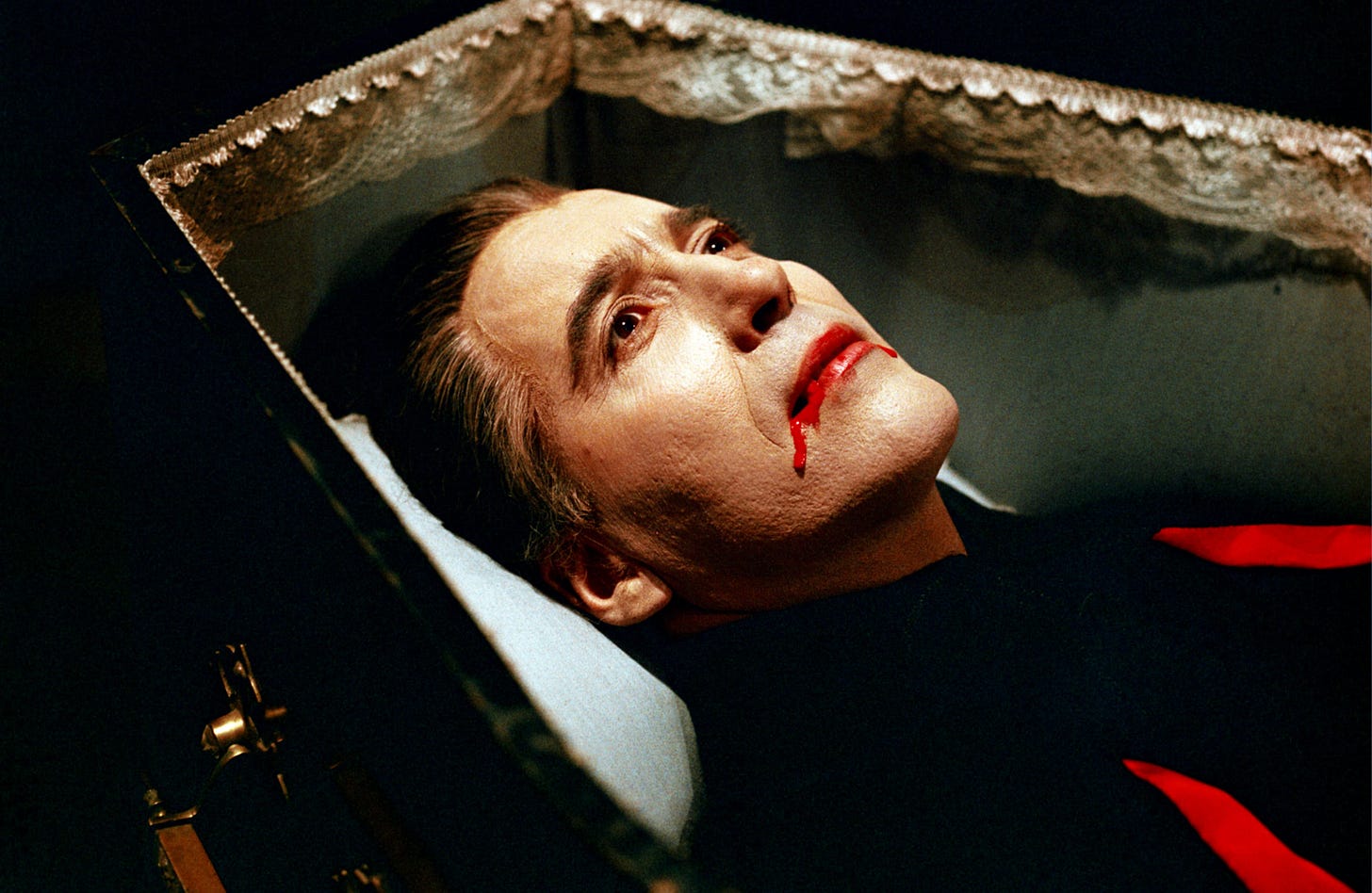Dracula Has Risen from the Grave (1968)
6/10
Christopher Lee dons the fangs, black cape and red contact lenses for the third time in Dracula Has Risen from the Grave—technically the fourth installment of Hammer Films’ series revolving around Transylvania’s most famous resident (the titular count does not appear in 1960’s The Brides of Dracula). Despite making some significant changes to vampire lore, the film is a definite step up from predecessor Dracula: Prince of Darkness, in which Dracula had no dialogue and merely hissed like a cat.
That baffling creative choice has been given two explanations. Dracula: Prince of Darkness screenwriter John Sansom claimed he didn’t write any dialogue for Dracula, while Lee claimed the dialogue was so ridiculous he refused to speak it. In any case, Dracula Has Risen from the Grave marks the first time Lee’s vampire speaks onscreen since his debut a decade earlier in Horror of Dracula—an astonishing fact given how known Lee is for his imposing bass-baritone voice.
It’s a welcome change, since Lee as always is the highlight of these films despite minimal screentime. His Dracula is magnetic every second he’s onscreen, and it’s a delight to hear Lee attack the theatrical, if basic, dialogue he’s been given (“Now my revenge is complete”). Like many older horror movies, the Hammer Dracula films are unlikely to scare most modern viewers given their slower pacing and often campy feel. Lee’s performance as Dracula is an exception: his imposing physical presence, burning bloodshot eyes, and animalistic savagery make for a frightful antagonist.
Plot-wise, it’s standard fare. In an East European village, a young woman is found dead in a church, another apparent victim of Dracula despite the fact that he was destroyed a year earlier in the previous movie. Visiting clergyman Monsignor Ernst Müller (Rupert Davies) attempts to put an end to the villagers’ fear by journeying to Dracula’s castle and exorcising the vampire once and for all. He brings along a local priest (Ewan Hooper) who inadvertently revitalizes Dracula and unleashes the count back on the world.
Enraged that his castle has been barred to him by Müller, who has fastened a large cross to the door, Dracula resolves to take revenge on the monsignor’s beautiful niece Maria (Veronica Carlson). He enlists the priest, now an obedient Renfield-like figure, to help him travel to Müller’s home city of Keinenberg. Why couldn’t Dracula just ask the priest to remove the cross from his castle door, as he does with another character around the film’s climax? Because then there would be no movie.
Director Freddie Francis and writer “John Elder”, aka Anthony Hinds, do a good job establishing the characters and setting in Keinenberg. Much of the action there revolves around a tavern and bakery where Maria’s boyfriend Paul (Barry Andrews) works. Paul is also a student and an atheist, which leads to a blowup when Maria invites him to dinner with her mother Anna (Marion Mathie) and the monsignor.
Paul’s atheism blows up in his face again when he tries to impale Dracula with a wooden stake through the heart. In a convenient plot twist, the filmmakers have decided it’s not enough to drive a stake through the heart of a vampire. Instead, one also has to say a prayer and potentially be religious. Paul can’t bring himself to say a prayer, which allows Dracula to remove the stake from his heart and immediately heal. Would it have worked if Paul had said a prayer even without believing in God? The film is unclear.
The actual amount of Dracula’s victims is surprisingly low, though upon reflection this tends to be the case for Dracula films. Other than mentally enslaving the priest, Dracula only sinks his fangs into two characters, both women: tavern girl Zena (Barbara Ewing) and Maria. That’s not surprising when one considers the strong erotic undercurrent of vampire fiction and Dracula stories in particular. In the Hammer Dracula films, Dracula exerts a magnetic power over women who eagerly bare their necks to him.
Dracula Has Risen from the Grave takes this a step further by showing Zena and Maria enter what are, in effect, instant abusive relationships. Dracula is a menacing stranger whom they immediately allow to bite them and drink their blood. He slaps the women around, orders them about and treats them with contempt, yet they remain utterly devoted to him. In their second encounter together, Dracula strikes Zena across the face and demands that she bring Maria to him. “What do you want her for? You’ve got me!” Zena says. Nevertheless, she obediently brings Maria to Dracula.
The relationship between Dracula, Zena, and Maria darkly parallels a love triangle between the two women and Paul. Dracula Has Risen from the Grave tends to see women through the lens of the Madonna-whore complex, since the only female character other than Zena and Maria is the matronly Anna. Red-headed Zena is assigned the role of “whore”. When Paul comments that she seems to have many boyfriends, Zena tells she can always use one more. He returns her advances only when he gets drunk after being forced to leave Maria’s home. Meanwhile, blonde Maria is the “virgin”, devoted only to Paul—then to Dracula.
Truth be told, the film never says what Dracula’s exact plan is regarding Maria. Does he intend to make her his bride? Much of the film is vague or unclear when it doesn’t display outright lapses in logic. The dead girl found in the church at the beginning appears to have two bite marks on her neck. We’re supposed to believe Dracula’s evil still casts a shadow over the village, even though the vampire himself has been destroyed. If the girl committed suicide, that would suffice as an expression of his continuing dark influence. But the puncture wounds on her neck imply Dracula is going around biting people, which makes no sense if he’s frozen under ice and renders meaningless the priest reviving him.
Then there are the changes to traditional vampire lore. Requiring the person who stakes Dracula to recite a prayer has a certain logic to it; Dracula Has Risen from the Grave reflects the oddly conservative nature of many horror films, as Paul’s character arc sees him regain his Christian beliefs. But what of scenes in which Dracula appears to be walking around in broad daylight? Are we supposed to believe this is late dusk? The lighting onscreen doesn’t bear that out. It feels more like simple laziness on the filmmakers’ part.
Still, I enjoyed the film. It’s easy to be more forgiving when movies have shorter running times, in this case 92 minutes. I got what I came to see: Christopher Lee commanding the screen as Dracula, and given more dialogue, in a campy but atmospheric old-school British horror movie with blood and sex appeal. Paul’s atheism makes for an interesting new addition to the formula, even if it could have been explored more. I’d put this one more or less on par with Horror of Dracula.








